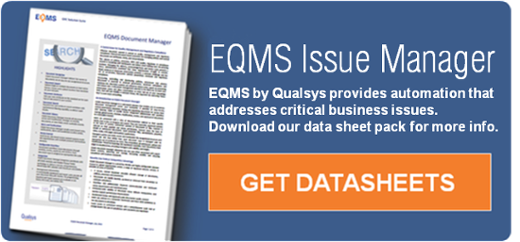Want to contribute to this article?
The EQMS User Group on 22 March revealed a multitude of ways that customers are using Issue Manager. We’ve taken our ten favourite examples to give you an idea of how the module could benefit your organisation, from process efficiency and handling customer complaints through to document reviews and RIDDOR reporting.
#1 Purchase Orders
Here at Qualsys we use EQMS Issue Manager to raise Purchase Orders for the organisation. It creates a simple but effective digital trail to allow for quick audits and easy to find records. Purchase Orders are raised using the Job Tracker function, triggering an automated workflow to selected users.
#2 Marketing Request
Whether an internal marketing team process, or an external request, EQMS Issue Manager can help you to handle marketing tasks. There may, for example, be an interesting news story that has arisen from your customer services department. This can be raised as a request to the marketing department, who are then alerted to the request and can deliver timely marketing such as creating a press release or writing a blog article about the customer news story.

#3 Service Delivery Tracking
EQMS Issues Manager has automated, customised workflows that can be attributed to any task. This means that once an issue has been raised, the right people are notified with an email and an action in their to do list.
This is particularly useful to track service delivery processes, ensuring SLAs are adhered to by creating workflows with time restrictions – so that people have to carry out their related action before the deadline. It puts accountability onto the individual for their role in service delivery, and minimises the risk of service delivery delays or issues.
![]()
#4 Security Alerts
A large site means it can be difficult to be aware of everything going on, everywhere, at all times. EQMS Issue Manager enables anyone to raise an issue, so if something is spotted as a physical, external, or digital risk, it can be highlighted and immediately put into an urgent automated workflow for fast action.
For example, a report can be made of a broken perimeter fence, and the right people can be alerted (those who work in the area, the maintenance person required, and an alert to someone who deals with external suppliers if contractors are required to fix the problem).
#5 Process Improvement & Suggestions
Any registered user (whether licensed or a free end user) can raise a point in EQMS Issue Manager. The idea behind this is to deliver clarity, openness, and encourage a culture of quality across the organisation. If an individual sees a way to improve a business process, they can raise this as an issue. The dedicated custom workflow will trigger a notification to relevant people (such as a group of line managers) who can discuss the suggestion and feed back to the individual on the next steps.
#6 HSE – RIDDOR Reporting
Reporting of Injuries, Diseases, Dangerous Occurrences Regulations (RIDDOR) mean Health and Safety Managers must be fully aware and have processes in place to deliver reports in a timely, easy-to-interpret, and auditable fashion. The ability to track how incidents, or potential incidents, are dealt with enables HSE Managers to remain compliant with regulations.
EQMS Issue Manager provides a comprehensive reporting process using visual dashboards for customisable reports depending on the audience required. A full report, for example, can be disseminated to the HSE team for scrutiny and performance improvement, while KPIs can be extracted for reports to the executive board.
#7 Legal Contract Change
One of our customers regularly handles legal contracts, which may require changes. They use EQMS Issue Manager to raise issues on a legal contract, which are then automatically triggered to be sent to the right people (such as the legal team) for review.
Doing this ensures all changes are peer reviewed and changes made are certified by those who will be held responsible to the contract terms, mitigating future risk and ensuring individuals commit to continuous quality improvement in legal contract developments.
#8 Complaint Handling
Complaint handling is a critical business process, vital to the quality output of a company. Several of our customers use EQMS Issue Manager to create complaint handling workflows.
Once a complaint is logged, the next person in the workflow is automatically notified and can carry out their action. So it goes in a chain of command, and all complaints can be handled in a consistent manner within agreed timelines.
The reporting dashboard allows a quick overview of ‘jobs’ – in this case, complaints raised, and can be customised to demonstrate average response time, time to close, and even individuals who raise or receive the most complaints.

#9 Business Change Control
Managing business change is a common sticking point for Quality Managers, and our customers have their fair share of stories – some successful, others less so. The key to managing business change is to implement systems and processes where communication and feedback can be delivered at all stages of the change.
EQMS Issue Manager has been used by several customers to create a workflow which links to EQMS Document Manager. This enables them to create, upload, and notify others of document change – such as new policies – while Issue Manager workflows allow for changes to be made within a controlled process.
#10 Meeting Minutes
A simple, but effective, way of using EQMS Issue Manager is to raise meeting actions for individuals to carry out. The triggered workflows, which are entirely customisable and allow for individual users to be attributed to an action or a stage, mean that meeting actions are guaranteed to be carried out in time.
Individual users who have a meeting action raised within EQMS Issue Manager will receive an email notification as well as a reminder in their To Do List. This ensures the action is seen and carried out within the required timescale, such as before the next meeting.
What You Should do Now
If you need a system that handles a wide range of tasks, and makes the most of automation to minimise the administration (and time taken chasing other people!), you can find out more from the EQMS Issue Manager Datasheet download here.








Share your thoughts on this article